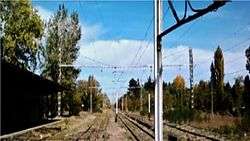Monte Águila
| Monte Águila | |
|---|---|
| Town | |
|
Monte Aguila Station | |
| Region | Bío Bío |
| Province | Bío Bío |
| Population (2002 Census) | |
| • Total | 6,090 |
| Time zone | CLT (UTC−4) |
| • Summer (DST) | CLST (UTC−3) |
| Area code(s) | 56 + 43 |
| Website |
www |
Monte Águila (English: "Mount Eagle") is a Chilean city in the Bio Bio Region. Its population is 6,090.
History
The history begins with the indigenous Mapuche and Araucanian people settled in the area of Monte Águila, belonging to the district (es:subdelegación) of Yumbel. In 1852, this group of natives, led by Lonco Nancomawuida (Ñancomahuida, in Spanish), was forced to leave the area as a result of legislation introduced by the government of Manuel Montt. This enabled the area to be colonized by German immigrants, led by Hans Frank and Martin Worman. An important event in the development of Monte Águila was the construction of the state railway in 1864. After the War of the Pacific (1880), the town served as a transport hub from which weapons and future soldiers were transported in carts and rail cars. In 1887, a trade link was established between Monte Águila and the Argentine city of Neuquén, which lasted until 1968, a period in which Monte Águila saw much economic and social development. Also important to the growth of Monte Águila as a city was the construction of the branch line between it and the Polcura River. The trans-Andean railway, whose construction began in 1905, was funded by Porfirio Ahumada, a Chilean national, and his partners Corsini, Carlos Viel (engineer), Martin Worman and Horacio del Río. This was a key event in the formation of Monte Águila, enabling the city to come together and achieve rapid growth, bringing with it social and cultural development.[1]
References
- ↑ Sanhueza, Juan. "Monte Aguila "Cada día te quiero más" VIII Región del Bío Bío – Chile". www.monteaguila.cl. Retrieved 2015-05-31.
External links
Coordinates: 37°04′49″S 72°26′24″W / 37.0803°S 72.4399°W
